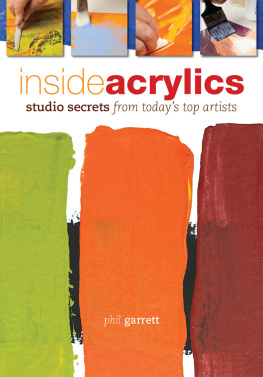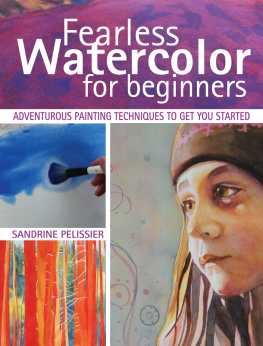Sign up for our newsletter and receive special offers, access to free content, and information on the latest new releases and must-have art resources! Plus, receive a coupon code to use on your first purchase from NorthLightShop.com for signing up.
Today artists have a vast array of drawing and painting mediums to choose from in order to express their artistic vision. Each calls out a unique set of techniques that lead to successful artwork. Oil painting alone, being close to six hundred years old, has passed through three distinct technological periods. Each period gave us a complete set of materials to use for oil painting, so the complexity is hugeand thats only one medium! Therefore, its important to have a guide to help you navigate through the various art materials and help you choose the right supplies to make the kind of work that you desire.
About Robert Gamblin
Robert Gamblin is a painter and the founder of Gamblin Artists Colors, (gamblincolors.com), an international brand of oil-painting materials. He also founded Gamblin Conservation Colors (conservationcolors.com). The company makes color for conservators and restorers worldwide to use in the repair of damaged artwork. Visit his website at gamblinstudio.com.
As I write this, I am thinking of you, the reader. Some of you will make art that may find its way into important museums. Some of you will sell your work through art galleries, and some will make art that will become valuable heirlooms within your family. A commonality in all of this is the need for permanence. Quality art materials will deliver this permanence, but that is only half the equationartists must construct their paintings or drawings in a sound manner. Then the artwork will hold the artists vision for many centuries. Regardless of how you draw or paint, the laws of physics still apply. A little craftsmanship will go a long way towards creating successful and permanent artwork.
If this is your goal, you have come to the right place to learn how to choose materials and tools to make artwork that will convey your thoughts, feelings and the images that fascinate you.
Ed Brickler has a rare talent for education. Thousands of art students have benefited from his teaching and now, through this book, artists far and wide can gain access to his thoughtful, clear and organized lessons on painting and drawing, and best practices for using various art materials.
Because many artists are either self-trained or trained through art programs that focus on ideas to the exclusion of materials and techniques, there is a great need for technical training. This book is a great contribution to fill that void.
Ive known Ed Brickler for more than twenty years, and have had the opportunity to travel and paint with him. His knowledge is extensive and he is dedicated to teaching artists how to choose and use art materials. Eds book is an expression of his passion for sharing this knowledge.
Robert Gamblin
Introduction
When I started my career as an artist, I knew very little information on art materials and techniques, and the Internet didnt exist. I could paint and draw, but I really wanted to know how the various mediums and tools worked and the proper techniques for using them. So I stumbled along, learning as much as I could from other artists.
It wasnt until the mid-1980s when I entered the art materials industry that I was introduced to The Artists Handbook of Materials and Techniques by Ralph Mayer, The Painters Handbook by Mark Gottsegen and The Materials and Techniques of Painting by Kurt Wehlte. I also had the privilege of working with Russell Woody, artist and mentor, who taught courses on materials and techniques and wrote one of the first books on acrylic painting, Polymer Painting and Related Techniques. These books provided the knowledge I sought and became the catalysts for me to continue my research.
After years of conducting countless lectures and demonstrations on art supplies and methods for various mediums, it is my opinion that an artist who has a general knowledge about all art materials and techniques is more proficient in creating art. Understanding benefits as well as limitations of specific materials and tools of the trade is the starting point of the creative process. If we understand the limitations of the materials, we will know how far we can push them in our creative processes. After all, we are artistsbending and breaking the rules is a form of creative expression.
Hopefully this book will serve as an all-encompassing guide to the various art materials available for artists today, teach you important techniques for using various mediums to the maximum potential, and take you beyond the knowledge of art supplies to ignite your imagination.
Ed S. Brickler
CHAPTER 1
Tools
Basic tools are a part of every artists studio and a necessary part of the creative process. The type and number of tools depends on the artists preferred medium. Apart from graphite, paints and other mediums, which will be covered in depth later in this book, there are many tools that aid mark-making. Basic tools are comprised of but not limited to drawing tools, brushes, painting and palette knives, palettes and fixatives. In looking for these tools, you will find that there is quite a variety of manufacturers and qualities. Allow yourself the time to experiment with different brands and productseventually you will figure out what works best for you.
Erasers
Erasers are often thought of as a correction tool, but they can also be used to alter a mark or even make a mark. They are available in block form, pencil form and long cylindrical forms for use in a holder.
TYPES OF ERASERS
- Natural rubber eraser: The most popular eraser of this type is the Pink Pearl, but they come in other colors as well. This eraser is made from an abrasive hard rubber and should be avoided because it can destroy the surface of most fine-art papers.
- Vinyl or plastic eraser: These are much less abrasive than natural rubber erasers, but they still have their own range of abrasiveness. They are available in a variety of colors and shapes. Like most artist tools, it is always advisable to test an eraser before using it on that masterpiece.
- Kneaded eraser: The kneaded eraser is also made of rubber, but is absorbent to a certain extent. It can be cleaned by kneading it, hence the name. Besides erasing, it can be used for blending and adjusting value. Eventually the eraser will become full of the medium erased and will need to be replaced.









